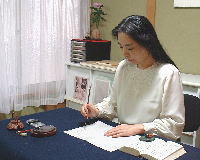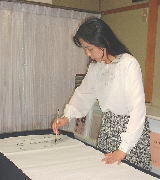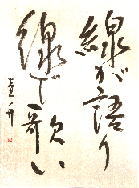Oriental Calligraphy meets Internet
-What do we see in the fusion of tradition and new technology?
Advanced technology changes every life style as we have already witnessed. Although traditional art looks incompatible with modern technology in general, many experimental efforts indicate that Oriental Calligraphy has potential to create a new art world in combination with internet technology. This is a little study of the future of Oriental Calligraphy, one of the Japanese old traditional arts in the middle of paradigm changes brought by computer technology.
History of Oriental Calligraphy Calligraphy and internet Oriental Calligraphy at present
Method for Proficiency Improvement Calligraphy lives out as art
What is Oriental Calligraphy?
I would like to try to explain what the Oriental Calligraphy is specifically for foreigners who may be new to it.According to "Koujien" which is the largest Japanese dictionary, the meaning of calligraphy is as follows;
- Writing, fair copy
- Written letters, handwriting
- Note, letter
- Literature, document, book
- Sutra
All except for item 5 exist every where in the world, however, oriental people have exceptional ways of appreciation for calligraphy.
For items 1 and 2, Oriental Calligraphy is emphasized more on appearance and style than contents.
Pleasure of Oriental Calligraphy like vocal music

What is the attraction of Oriental Calligraphy?
There are many countries where calligraphy is not necessarily appreciated from an artistic view point. However, there are ideas and devise in writing technique to try to catch eyes on letters, which are represented by such a word as lettering even in thos countries.
Autograph is handwriting and it has been developed as a subject for appreciation in the Orient and thus, the pleasure of Oriental Calligraphy is appreciation of handwriting.
Music in Japanese language is written in two words, "Sound" and "Joy" meaning "joy of sound".
There is no letter of "joy" in the Japanese language meaning calligraphy, but Oriental Calligraphy is as enjoyable as music.
Music has two categories, instrumental and vocal music. To me, painting is like instrumental music but Oriental Calligraphy is more like vocal music. Both painting and the Calligraphy are hand work but different from painting, the Calligraphy is based on characters and words, which may have some thing to do with vocal music. As enjoyable to listen to variety of voice quality, different techniques of singing and wide scope of lyrics in music, Oriental Calligraphy presents many ways for joy such as different line features specific to calligrapher, variation of styles and techniques, reproduction of wonderful poems, characters and words.
History of Oriental Calligraphy
As vocal music came automatically into being when phonetic language began, calligraphy was supposed to appear at the same time with written language.
As there are shouting, talking, story telling and singing in the phonetic language, there are ways of expression depending on objectives such as signboard, letter, document, literary work in the written language.
There must have been many reasons why Oriental Calligraphy has developed so much in a unique way in Japan. Let me make a list of thinkable reasons randomly.
- Chinese character consists of pictograph and indication part which gives strong visual appeal.
- It takes years to learn Chinese letters because of the numerous numbers.
- Japanese language is peculiar in such a way of metaphoric expression.
- A calligraphy brush brings about full of expression from weakness to strength.
- Motion of pulling brush for vertical line rouses pleasant feeling with excitement.
- Calligraphy was once a means for finding work.
- Calligraphy is said to express personality and a good calligrapher is respected.
- Calligraphy is connected with such cultural activities as tea ceremony, literature and painting.
- Not limited to paper media, there are other ways such as stone cutting, dyeing, pottery glazing or even digital media, which broaden nature of pleasure.
- Good for a posture, concentration and as Calligraphy takes up Chinese classics and Japanese poems, it helps improve academic ability.
- Calligraphy is too profound to master and there are many people regardless sex and age who want to learn it.
- Calligraphy has been traditionally loved by those who believe that it is healthy for body and soul and for prenatal influence.
- Most Japanese wish for a better calligrapher.
Calligraphy and internet

For most people, it is most difficult to write Japanese letters with a calligraphy brush followed by a fountain pen and then a sharp pencil.
Of course, it depends on person but in general a ball point pen and a pencil are easy to write with and more so with the keyboard.
Even if Oriental Calligraphy is gone, it does not mean that the literally culture disappears. However, I doubt that Japanese people can tolerate the world in printing type alone. Just imagine that if the voice language becomes synthetic voice alone without vocal music and various story-telling arts, you must definitely want to listen to natural voice and utter yourself.
Even in the age of internet, the number of postal letters is said increasing. Why? It is simply because people feel warmth or hearty emotion in handwriting, isn't it?
Through my experience to make my own homepage featuring Oriental Calligraphy I have learned that image is more appealing and persuasive than voice. I strongly believe that Oriental Calligraphy has potential to develop further as a means to get across individual personality in internet communication. And more importantly, I found that the advanced image processing technology could open a new world which we have never had before. Because Oriental Calligraphy is an unique and ideal base material for image processing as mentioned earlier in the list of aspects. Also, the research opportunity increases greatly through internet to learn other schools, various knowledge and techniques such as Chinese letters, Japanese syllabi, stone cutting and so forth, which may help develop new and more personal style in Oriental Calligraphy.
Oriental Calligraphy at present
As described so far, Oriental Calligraphy fulfills the necessary conditions to be recognized as the pure art, however, it is also true that there are some people who think that its position among other art forms is little different.
I would like to try to have a little insight into it.
In order to catch up with western modernization, Japanese government in Meiji era starting 1867 tried to make a model on Europe for every social system. Japanese police system, for instance, mimicked French one. And after the Pacific War ended in 1945, United States took over Europe as a model. In this dynamic movement toward westernization that automatically caused changes more or less in the sense of values of Japanese, Oriental Calligraphy had been put aside as one of the old forms of Japanese traditional arts. As a result, music deafness has gone by the modern music education but young Japanese who can't use calligraphy brush or even chopsticks properly has been increasing.
Also modern houses eliminate alcove and fanlight in a traditional Japanese room where art or flowers are displayed. This has taken people away from daily opportunity to appreciate Oriental Calligraphy or other oriental arts.
On the other hand, ancient documents and cultural heritage lied under the ground have been discovered one after the other both in China and Japan, which has continued to stimulate the research of Oriental Calligraphy. And associated with the advancement of printing technology, numbers of masterpieces in Oriental Calligraphy have been born during these periods, which are comparable to Heian era between 784 and 1184, a golden age in the history of Oriental Calligraphy in Japan.
In the list of reasons previously shown, there is a reason stated "calligraphy was once just a means for finding work". This was typical after compulsory education started in 1900 or 33rd year of Meiji because illiteracy became a major obstacle for getting a job. Resume was written using a calligraphy brush at first. As applicants wanted nicely written resume, professionals to write for them became popular. However, the calligraphy brush was taken over by a fountain pen after the Pacific War.
And now, word processing is an ordinary means for resume. There are many companies which still require resume in handwriting. It indicates that people still think that handwriting reflects personality and general ability of a writer.
With such historical ups and downs of the position of Oriental Calligraphy in the Japanese life, the today's state of it looks quite solid and people's awareness to see it as an art has been raised greatly.
Method for Proficiency Improvement
Many Japanese want to learn the more efficient method for improving proficiency in Oriental Calligraphy. In fact, so many books are available for it. Although it is good to learn from the books, proficiency improvement is primarily the same for learning singing. If you use calligraphy brush as much time as you use a microphone for Karaoke, your improvement is surely promised.
The first thing to do is to get into the swing of Oriental Calligraphy by daily accustom to use brush even for a very short time to write diary or to copy passages from sutras.
In addition, to see genuine articles and meet a good coach are important so as every thing.
Calligraphy lives out as art
You may be right if you say that handwriting is OK only if others can read. Especially at the age when personal computer takes over utilitarian writing, the existence value of Oriental Calligraphy depends upon how people think their life when clothing, food and housing were all satisfied.
|
Oriental Calligraphy is a form of total art. Because it uses letters as base material, visionary and phonation function are used both for writing and appreciation. As there are colors and shapes involved, it is a fine art. The factor of imaginative literature is also included. Rhythm and cadence in writing is like singing, playing music, dancing or sport to use whole body. It is supported by traditional literary tools. It has vast utilization areas. There are many places to be active in various fields for every calligrapher can work in with.
It has become an old story now that you would never grow senile if you play samisen by the left hand and hold calligraphy brush on the right hand or that Japanese who are good with one's hands have excellent and top potential in academic ability in the world.
From my research about the historical fate of Oriental Calligraphy, I think I now understand why Oriental Calligraphy has not been designated statutory subject for preservation of cultural assets. But at the same time, I see a bright and limitless future with Oriental Calligraphy by the utmost use of still growing internet technology.
